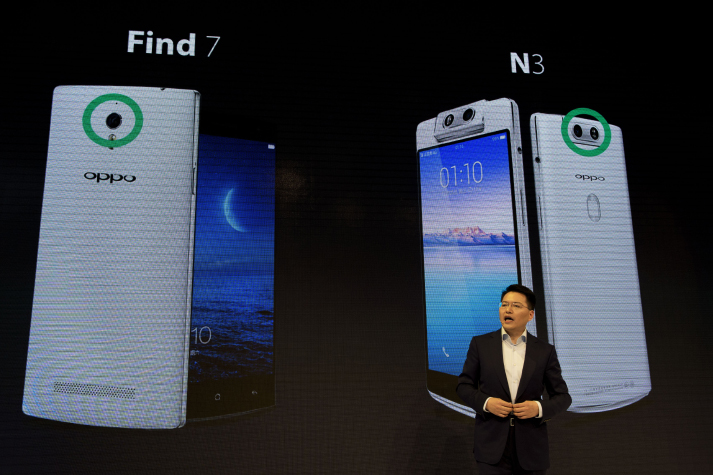| Business |
| Chinese Phones Counterattack | |
| Domestic mobile phone makers rise to gain larger shares in the mid-level and high-end market | |
|
|
 Andy Jiang from OPPO speaks during the presentation of their new devices at the Mobile World Congress 2017 in Barcelona, Spain on February 27 (XINHUA/LINO DE VALLIER)
The smartphone industry is leading the growth of consumption in China, and Chinese brands such as Huawei and Xiaomi are likely to gain more mid-level and high-end market share. Rising stars such as OPPO and Vivo are successfully marketing and satisfying demand in a targeted way. Profit makers Compared with the famous Huawei and Xiaomi, OPPO and Vivo used to be invisible in the "red ocean" of smartphones. These two brands were seldom covered by media until 2016, when they ranked as global leaders in smartphones. According to figures from global market intelligence provider IDC, OPPO and Vivo both ranked in the top five smartphone brands globally in the first quarter of this year, with a combined 12.6 percent market share, leaving previous industry leaders such as Motorola, LG and Sony as well as other domestic brands such as Lenovo and ZTE far behind. OPPO and Vivo are eye-catching because not only are they growing rapidly, but also they come from the same birthplace—Chang'an Town of Dongguan, south China's Guangdong Province. Actually, they come from the same company—BBK Electronics Corp. The two brands were both registered by BBK, then divided into two separate companies, with Vivo used as a mobile phone brand in 2011, said Hu Baishan, Vivo's executive vice president. OPPO's vice president Zhu Gaoling said the company was established in 2003 and entered the smartphone industry only five years ago. Top-selling models illustrate how powerful their counterattack is. In January, the OPPO R9s created a top-selling record in China, with 3 million handsets sold that month, according to figures from CINNO Research. Figures from Strategy Analytics showed that in the first quarter, the OPPO R9s was the third best-selling smartphone in the global market, only behind the Apple iPhone 7 and Apple iPhone 7 Plus. However, this top seller is not a cheap model, but a mid-level to high-end one that is priced above 2,800 yuan ($420). "Having a best seller in the mid-level to high-end market, OPPO and Vivo have gained higher profits than their rivals at lower costs for advertising and sales channels," Zhang Yi, CEO of Chinese market survey firm iiMedia Research, told Economic Information Daily. According to Zhang, Apple Inc. now makes most of the profits in the global mobile phone industry, and many other smartphone makers only make meager profits although their products sell well. OPPO and Vivo attract the industry's attention because they are the most profitable smartphone makers in China. Creating demand OPPO and Vivo have deeply impressed the public with a flood of advertising and celebrity endorsements. Wang Tiemin, a professor with Guanghua School of Management at Peking University, said marketing is one of the factors for their success, but the core competitiveness of the two companies lies in their innovation and market insight. They have successfully realized the change from satisfying market demand to creating demand and guiding consumption. Targeting young users, OPPO and Vivo select pop stars to endorse their products and sponsor many TV entertainment programs. To satisfy female users who enjoy taking selfies, OPPO has remarkably improved the quality of its products' front-facing cameras. To solve the problem of phone battery charging, OPPO started developing quick-charge technology in 2013. Now it is famous for "two hours of talk after just five minutes of charging" with its VOOC quick-charge technology, which has 18 approved patents. "Industry insiders all know that Apple Inc. is very strict in quality control, but actually, Chinese brands are equally strict, or even more strict, in standards of quality control," said Tang Jianjun, General Manager of DBG Holdings Ltd., a manufacturing service provider for OPPO. Figuring out consumer demand is based on big data. Hu said through big data research, Vivo finds out what consumers like and then satisfies their demand. "All innovations should be consumer-oriented. There is a consumer research team in our company, which closely observes consumer behavior. The data they provide are an important basis for us to make decisions," said Hu. Like fast food chains McDonald's and KFC, OPPO and Vivo also position their shops close together. Wang Ning, a professor of consumer psychology at Sun Yat-sen University in Guangdong, said within a shopping center, two brands often located together attract more consumers than either brand would by itself even when it is known the two brands belong to the same company. This is the case with OPPO and Vivo, who are rivals but not engaged in price competition. Instead, they offer consumers more choices. Figures from telecom operator China Mobile show that more than 30 percent of OPPO and Vivo users choose the same brand when replacing their mobile phones, and 20 percent choose the other, sister brand.
Copyedited by Chris Surtees Comments to wangjun@bjreview.com |
|
||||||||||||||||||||||||||||||
|